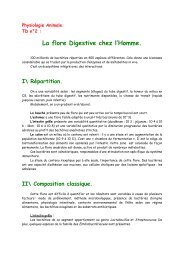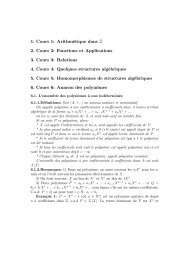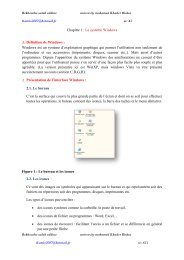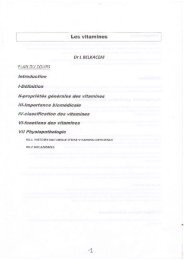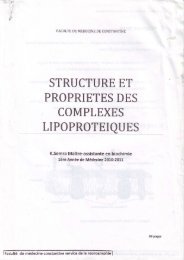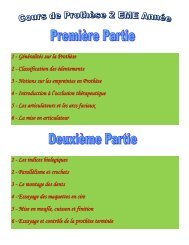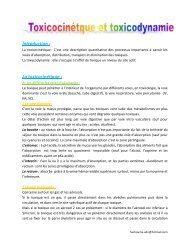- Page 2 and 3:
Fundamental Electrical and Electron
- Page 4 and 5:
Fundamental Electricaland Electroni
- Page 6 and 7:
ContentsPreface ...................
- Page 8 and 9:
Contents vii5.12 Figure of Merit an
- Page 10 and 11:
PrefaceThis Textbook supersedes the
- Page 12 and 13:
IntroductionThe chapters follow a s
- Page 14 and 15:
Chapter 1Fundamentals1.1 UnitsWhere
- Page 16 and 17:
Fundamentals 3where the ‘ k ’ i
- Page 18 and 19:
Fundamentals 5Since the basic unit
- Page 20 and 21:
Fundamentals 7S (mm)positiveslopene
- Page 22 and 23:
Fundamentals 9All materials may be
- Page 24 and 25:
Fundamentals 11Fig. 1.6Potential Di
- Page 26 and 27:
Fundamentals 13flow. Now, this pose
- Page 28 and 29:
Fundamentals 15then current I will
- Page 30 and 31:
Fundamentals 17(b)VR ohmI11. 55so,
- Page 32 and 33:
Fundamentals 19Note: Since P VI wa
- Page 34 and 35:
Fundamentals 21and distributed by t
- Page 36 and 37:
semiconductorFundamentals 23R (Ω)c
- Page 38 and 39:
Fundamentals 25PLEASE NOTE that the
- Page 40 and 41:
Fundamentals 27units. Another advan
- Page 42 and 43:
Fundamentals 29approved graph paper
- Page 44 and 45:
Chapter 2D.C. CircuitsLearning Outc
- Page 46 and 47:
D.C. Circuits 33(a)(b)(c)R R 1 R
- Page 48 and 49:
D.C. Circuits 35so V BC 8 VI V am
- Page 50 and 51:
D.C. Circuits 37In this context, th
- Page 52 and 53:
D.C. Circuits 39E 12 V; R 1 6 Ω
- Page 54 and 55:
D.C. Circuits 41Applying the potent
- Page 56 and 57:
D.C. Circuits 43more parallel resis
- Page 58 and 59:
D.C. Circuits 45R AC R AB R BC oh
- Page 60 and 61:
D.C. Circuits 47(b) The circuit has
- Page 62 and 63:
D.C. Circuits 49Worked Example 2.8Q
- Page 64 and 65:
D.C. Circuits 51that there are only
- Page 66 and 67:
D.C. Circuits 53BCDEB :42I 10( I I)
- Page 68 and 69:
D.C. Circuits 55Substituting this v
- Page 70 and 71:
D.C. Circuits 57As a check that the
- Page 72 and 73:
D.C. Circuits 59B(I 1 I 3 )6 Ω 4
- Page 74 and 75:
D.C. Circuits 61V I R and V I RAB
- Page 76 and 77:
D.C. Circuits 63BI 1(I 1 I 3 )R 1R
- Page 78 and 79:
D.C. Circuits 65From the above exam
- Page 80 and 81:
D.C. Circuits 67has been replaced b
- Page 82 and 83:
D.C. Circuits 69Assignment Question
- Page 84 and 85:
D.C. Circuits 71Assignment Question
- Page 86 and 87:
D.C. Circuits 732 Reverse the polar
- Page 88 and 89:
Chapter 3Electric Fields andCapacit
- Page 90 and 91:
Electric Fields and Capacitors 77Q
- Page 92 and 93:
Electric Fields and Capacitors 79He
- Page 94 and 95:
Electric Fields and Capacitors 81re
- Page 96 and 97:
Electric Fields and Capacitors 83Wo
- Page 98 and 99:
Electric Fields and Capacitors 85pe
- Page 100 and 101:
Electric Fields and Capacitors 87Wo
- Page 102 and 103:
Electric Fields and Capacitors 89Wo
- Page 104 and 105:
Electric Fields and Capacitors91C 1
- Page 106 and 107:
Electric Fields and Capacitors933
- Page 108 and 109:
Electric Fields and Capacitors 95(d
- Page 110 and 111:
Electric Fields and Capacitors 97AN
- Page 112 and 113:
Electric Fields and Capacitors 99Wo
- Page 114 and 115:
Electric Fields and Capacitors 1013
- Page 116 and 117:
Electric Fields and Capacitors 103P
- Page 118 and 119:
Electric Fields and Capacitors 105E
- Page 120 and 121:
Electric Fields and Capacitors 107A
- Page 122 and 123:
Electric Fields and Capacitors 109A
- Page 124 and 125:
Chapter 4Magnetic Fields andCircuit
- Page 126 and 127:
Magnetic Fields and Circuits 113dis
- Page 128 and 129:
Magnetic Fields and Circuits 115INF
- Page 130 and 131:
Magnetic Fields and Circuits 117Wor
- Page 132 and 133:
Magnetic Fields and Circuits 1194.8
- Page 134 and 135:
Magnetic Fields and Circuits 121A
- Page 136 and 137:
Magnetic Fields and Circuits 123How
- Page 138 and 139:
Magnetic Fields and Circuits 125For
- Page 140 and 141:
Magnetic Fields and Circuits 127FI
- Page 142 and 143:
Magnetic Fields and Circuits 129the
- Page 144 and 145:
Magnetic Fields and Circuits 131S2s
- Page 146 and 147:
Magnetic Fields and Circuits 133B(T
- Page 148 and 149:
Magnetic Fields and Circuits 135Φ
- Page 150 and 151:
Magnetic Fields and Circuits 137Ass
- Page 152 and 153:
Magnetic Fields and Circuits 139Met
- Page 154 and 155:
Chapter 5ElectromagnetismLearning O
- Page 156 and 157:
Electromagnetism 143When the magnet
- Page 158 and 159:
Electromagnetism 145moved verticall
- Page 160 and 161:
Electromagnetism 147Worked Example
- Page 162 and 163:
Electromagnetism 149Worked Example
- Page 164 and 165:
Electromagnetism 151IeIeRFig. 5.11I
- Page 166 and 167:
Electromagnetism 153Worked Example
- Page 168 and 169:
Electromagnetism 155rFig. 5.16an ef
- Page 170 and 171:
Electromagnetism157Now, flux densit
- Page 172 and 173: Electromagnetism 159A formeris also
- Page 174 and 175: Electromagnetism 161Fig. 5.22Dampin
- Page 176 and 177: Electromagnetism 163Worked Example
- Page 178 and 179: Electromagnetism 165Coil resistance
- Page 180 and 181: Electromagnetism 16712 V30 kR 1V70
- Page 182 and 183: Electromagnetism 169R110 1V1 V 0vo
- Page 184 and 185: Electromagnetism 171‘ zeroed ’
- Page 186 and 187: Electromagnetism 173Fig. 5.36the in
- Page 188 and 189: Electromagnetism 175Similarly, when
- Page 190 and 191: Electromagnetism 177The self-induce
- Page 192 and 193: Electromagnetism 1795.19 Factors Af
- Page 194 and 195: Electromagnetism 181This emf may al
- Page 196 and 197: Electromagnetism 183the above equat
- Page 198 and 199: Electromagnetism 185but, energy sto
- Page 200 and 201: Electromagnetism 187a common iron c
- Page 202 and 203: Electromagnetism 189dΦdtand d Φdt
- Page 204 and 205: Electromagnetism 191Alternatively,
- Page 206 and 207: Electromagnetism 193Assignment Ques
- Page 208 and 209: Electromagnetism 195Suggested Pract
- Page 210 and 211: Chapter 6Alternating QuantitiesLear
- Page 212 and 213: Alternating Quantities 199e(V)1.0E
- Page 214 and 215: Alternating Quantities 201emf (V)0T
- Page 216 and 217: Alternating Quantities 203(b) 3575
- Page 218 and 219: Alternating Quantities 205(b) v 55
- Page 220 and 221: Alternating Quantities 207Worked Ex
- Page 224 and 225: Alternating Quantities 211IinputD1D
- Page 226 and 227: Alternating Quantities 213(b)I fsd
- Page 228 and 229: Alternating Quantities 215Although
- Page 230 and 231: Alternating Quantities 217of using
- Page 232 and 233: Alternating Quantities 2196.14 Addi
- Page 234 and 235: Alternating Quantities 221Worked Ex
- Page 236 and 237: Alternating Quantities 223A(a)All f
- Page 238 and 239: Alternating Quantities 225glass tub
- Page 240 and 241: Alternating Quantities 227The Timeb
- Page 242 and 243: Alternating Quantities 229As the wa
- Page 244 and 245: Alternating Quantities 231Assignmen
- Page 246 and 247: Chapter 7D.C. MachinesLearning Outc
- Page 248 and 249: D.C. Machines 235Assuming no fricti
- Page 250 and 251: D.C. Machines 237E (V)0t (s)Fig. 7.
- Page 252 and 253: D.C. Machines 239for the field wind
- Page 254 and 255: D.C. Machines 241shown in Fig. 7.12
- Page 256 and 257: D.C. Machines 243increase with the
- Page 258 and 259: I fR fR aD.C. Machines 245I LI aVE
- Page 260 and 261: D.C. Machines 247would be infinite!
- Page 262 and 263: Chapter 8D.C. TransientsLearning Ou
- Page 264 and 265: D.C. Transients 251Having confirmed
- Page 266 and 267: D.C. Transients 253For such a CR ci
- Page 268 and 269: D.C. Transients 255Note: The time c
- Page 270 and 271: D.C. Transients 257can conclude tha
- Page 272 and 273:
D.C. Transients 259(a)initial d idt
- Page 274 and 275:
D.C. Transients 261Assignment Quest
- Page 276 and 277:
Chapter 9Semiconductor Theoryand De
- Page 278 and 279:
Semiconductor Theory and Devices 26
- Page 280 and 281:
Semiconductor Theory and Devices 26
- Page 282 and 283:
Semiconductor Theory and Devices 26
- Page 284 and 285:
Semiconductor Theory and Devices 27
- Page 286 and 287:
Semiconductor Theory and Devices 27
- Page 288 and 289:
Semiconductor Theory and Devices 27
- Page 290 and 291:
Semiconductor Theory and Devices 27
- Page 292 and 293:
Semiconductor Theory and Devices 27
- Page 294 and 295:
Semiconductor Theory and Devices 28
- Page 296 and 297:
Appendix APhysical Quantities with
- Page 298 and 299:
Answers to Assignment QuestionsChap
- Page 300 and 301:
Answers to Assignment Questions 287
- Page 302 and 303:
IndexAbsolute permeability , 119Abs
- Page 304:
Index 291Peak factor , 206Peak valu





